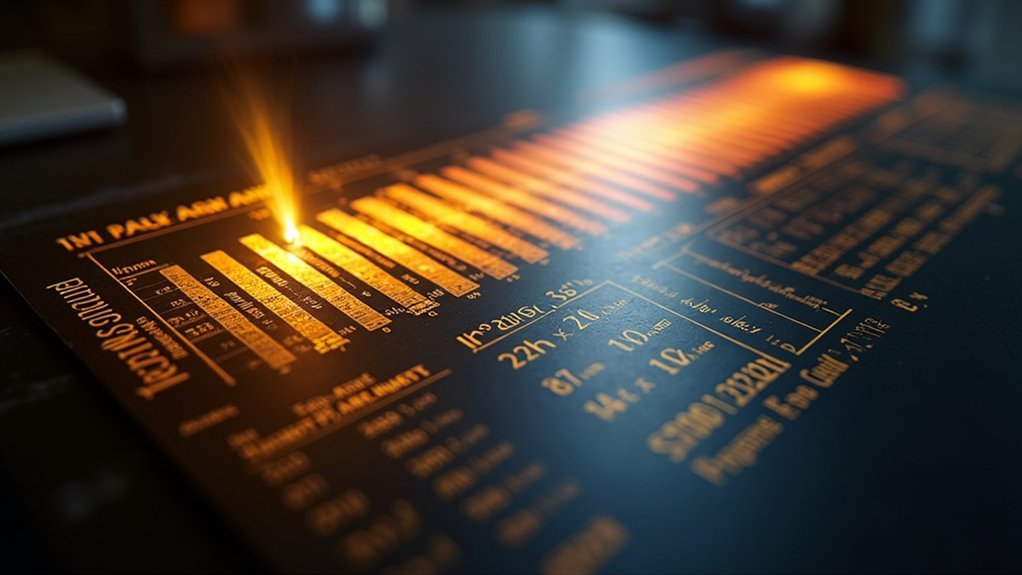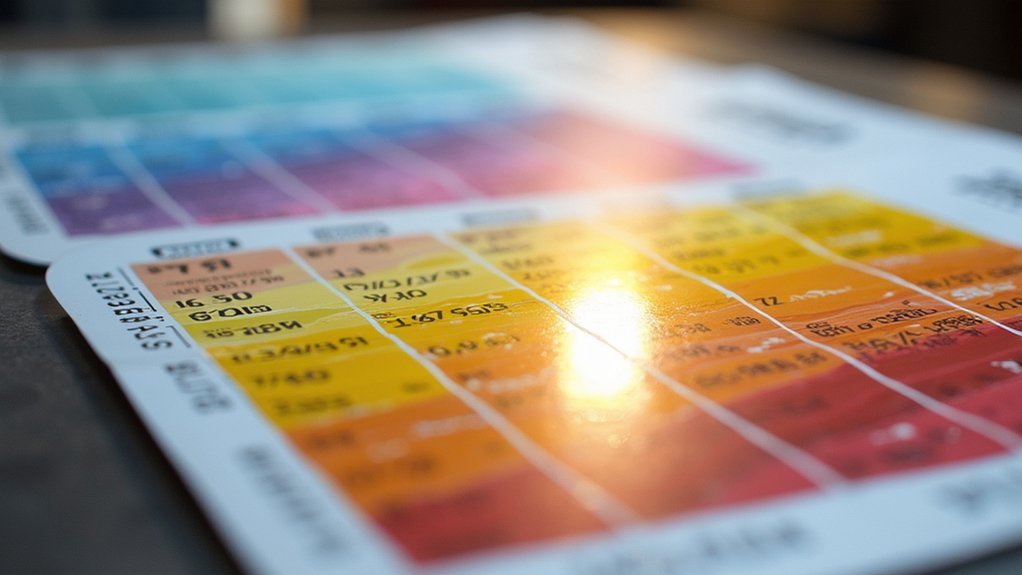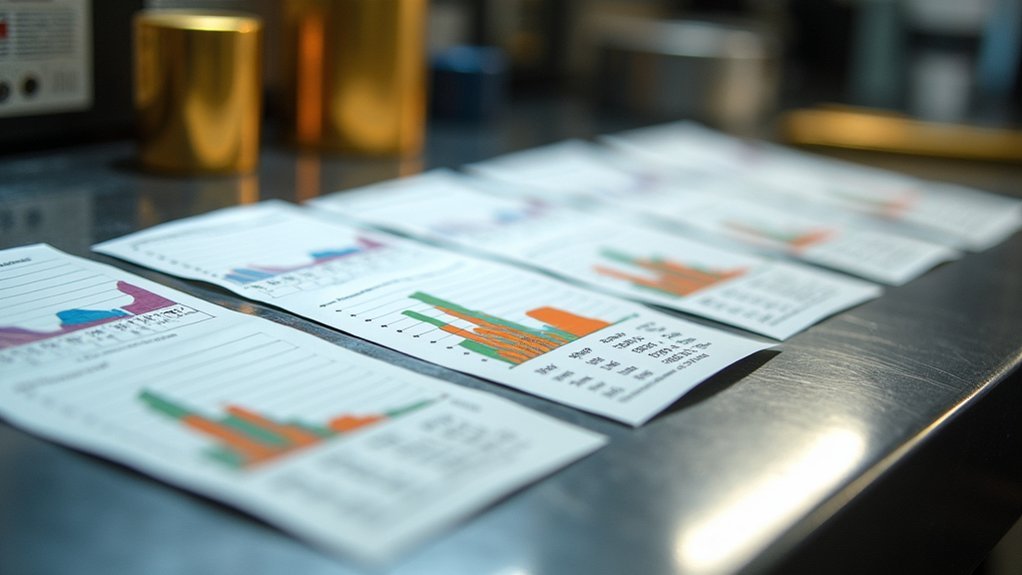You’ll find the most reliable gold solder flow temperatures range from 9ct solder at 1,060°F to 22ct solder at 1,450°F, with 14ct requiring 1,360°F for proper flow. Hard solders melt around 1,480°F for maximum strength, medium solders flow between 1,380°F-1,400°F for secondary joints, and easy solders work at 1,260°F-1,300°F for final assembly. Understanding these precise temperature thresholds guarantees you’ll select the right solder below your base metal’s solidus temperature for successful joints without accidental melting.
Understanding Solidus and Liquidus Temperatures in Gold Solder Applications

When working with gold solder, you’ll need to understand the critical difference between solidus and liquidus temperatures to achieve successful joints.
The solidus temperature represents the maximum heat your metal can withstand while remaining completely solid, while the liquidus temperature is when it becomes fully liquid. For 14K gold, these temperatures are approximately 800°C and 840°C respectively.
Understanding these temperature thresholds prevents accidental melting while ensuring your solder flows properly through the joint.
You must select solder with a melting point below your metal’s solidus temperature to prevent damage. This guarantees proper flow without melting your jewelry piece.
Different gold alloys and solder compositions create varying temperature ranges, so matching your solder choice to specific solidus and liquidus temperatures is vital for creating strong, durable connections in your goldsmithing work.
Comprehensive Flow Temperature Charts for 9ct Through 22ct Gold Solders
Since you’re working with various gold alloys, you’ll need specific flow temperature data to select the right solder for each karatage.
Understanding each solder’s flow point guarantees you’ll achieve the best results in your jewelry making projects.
For 9ct gold, expect a melting temperature around 1,060°F (571°C), perfect for delicate, low-temperature work.
Your 10ct solder alloys will flow at approximately 1,150°F (621°C), offering more versatility.
When you’re using 14ct gold, you’ll need to reach 1,360°F (738°C) for proper flow.
Moving to higher karatages, 18ct solders require 1,400°F (760°C), while 22ct reaches 1,450°F (788°C).
These higher temperatures accommodate premium jewelry making applications where strength and appearance are critical.
You’ll find these precise temperature ranges invaluable for selecting compatible solder alloys for your specific projects.
Cadmium-Free Vs Traditional Gold Solder Temperature Specifications

Although traditional gold solders containing cadmium offer lower flow temperatures ranging from 1,030°F to 1,240°F (554°C to 671°C), you’ll discover that cadmium-free alternatives now provide comparable performance with only slightly higher melting points between 1,050°F and 1,300°F (566°C to 704°C).
When selecting between these options, you’ll need to take into account that cadmium-free gold solder eliminates serious health risks while maintaining effective joining capabilities.
The low melting point advantage of traditional cadmium solders makes application easier and reduces risk of damaging surrounding components. However, you can adapt your soldering techniques to accommodate the slightly higher melting point of cadmium-free alternatives.
Understanding these specific temperature ranges guarantees you’ll achieve strong joints without compromising your jewelry’s integrity, regardless of which solder type you choose.
White Gold Solder Flow Points and Compatibility Guidelines
Understanding white gold solder compatibility requires matching flow points to your base metal’s solidus temperature to prevent catastrophic melting during assembly. You’ll need to select solder paste with flow temperatures below your parent metal’s solidus point—for 14ct white gold at 800°C, choose solders flowing at lower temperatures.
| Solder Type | Caratage | Flow Temperature |
|---|---|---|
| Hard | 14ct | 780°C |
| Medium | 12ct | 745°C |
| Easy | 10ct | 710°C |
| Extra Easy | 8ct | 675°C |
| Repair | 6ct | 640°C |
Always start with hard solder for initial joints, then progress to easier types. This technique maintains solder joint strength while preventing melting point conflicts. Proper flux selection enhances flow characteristics and prevents oxidation throughout your soldering sequence.
Hard, Medium, and Easy Solder Temperature Ranges for Multi-Joint Assembly

Multi-joint assemblies demand precise temperature control to prevent remelt of existing connections.
You’ll need to understand the three distinct temperature ranges for sequential soldering success.
Hard solder operates at the highest melting point around 1,480°F (804°C), providing maximum strength for your initial joints.
This high-temperature foundation guarantees subsequent operations won’t compromise your primary connections.
Medium solder melts between 1,380°F-1,400°F (704°C-760°C), allowing you to create secondary joints without affecting previously soldered areas.
You can confidently work knowing your hard solder connections remain intact.
Easy solder features the lowest temperature range at 1,260°F-1,300°F (682°C-704°C) for final assembly work.
Frequently Asked Questions
What Temperature Do You Solder Gold At?
You’ll solder gold at temperatures slightly above the solder’s flow point but below the gold’s melting point. For 14K gold, use around 1,360°F, while 18K requires approximately 1,430°F for proper flow.
What Is the Best Solder for Gold?
You’ll want high-quality gold-silver-copper alloy solders matched to your gold’s caratage. Choose cadmium-free options with appropriate flow temperatures—around 1,360°F for 14K gold—to prevent melting your workpiece.
What Is the Reflow Temperature of Gold Tin Solder?
You’ll find gold-tin solder’s reflow temperature ranges from 270°C to 350°C, depending on alloy composition. The eutectic 80% gold, 20% tin combination reflows at precisely 280°C for ideal results.
What Is the Difference Between Sn63 and Sn62?
You’ll find Sn63 contains 63% tin versus Sn62’s 62% tin content. Sn63 melts at 183°C while Sn62 melts slightly higher at 183-185°C, giving Sn63 better wetting properties.
In Summary
You’ll find these temperature charts essential for precise soldering work. Master the solidus and liquidus points for each gold karat, choose cadmium-free options when health’s a concern, and match white gold solders carefully to your base metals. Remember that hard solders flow at higher temperatures, so you’ll start with those for multi-joint assemblies, then progress to medium and easy solders to avoid remelting previous joints.





Leave a Reply